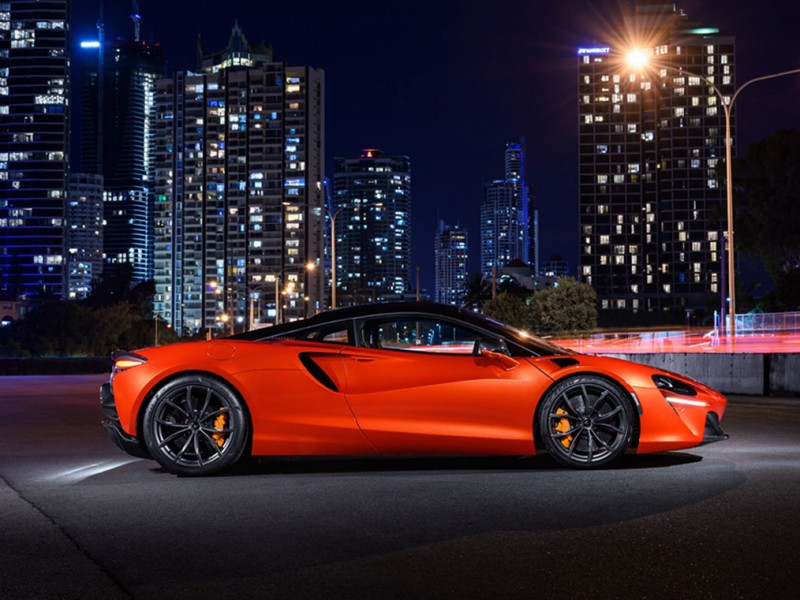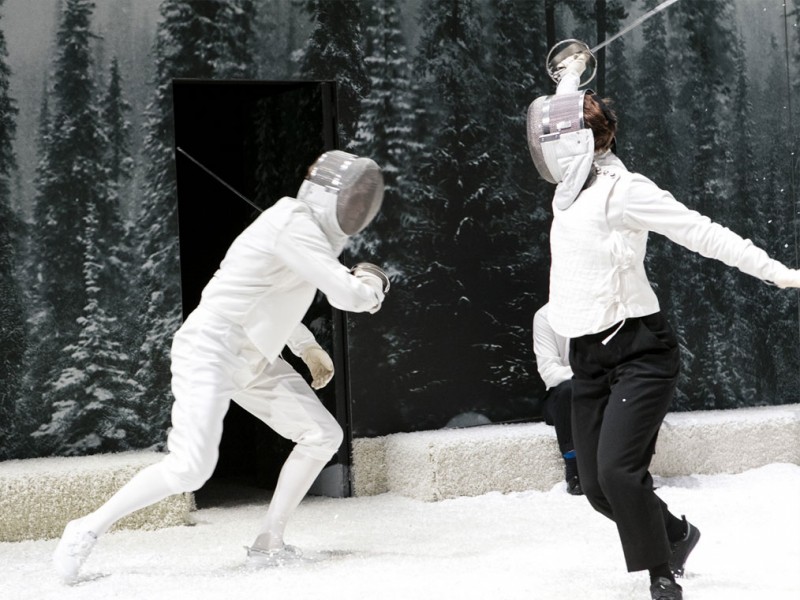Speculative design studio Superflux invites humanity to reassess its place in the natural world, emerging from the grid-like ashes of fire-blackened trees into resurgent greenery – and a glistening pool with a surprise below the surface. Invocation for Hope is a vast, immersive installation that examines the complex interconnected relationships throughout the natural world, and which raises the possibility of a more-than human future – a post-anthropocentric planet in which humanity is just one part of a dynamic and multifaceted ecosystem.
After travelling through a grid-like forest of burnt and blackened pines – the unexpectedly graceful skeletons of a former time – you find, at its heart, a resurgent living forest, where multiple species living in harmony with humanity offer a promise of alternative life. In this cradle of biodiversity, you come to a freshwater pool, which reflects, not your own face, but another creature – a wolf, a lynx, a bison – coming to the water to drink. Accompanied by a soundscape created by visionary musician Cosmo Sheldrake, the installation leads viewers one by one on a personal journey from the ravages of climate crisis to the possibility of renewal and a deeper connection with nature.
The planet post-catastrophe.
Invocation for Hope was commissioned by the Museum of Applied Arts (MAK) for the Vienna Biennale for Change 2021 in response to the event’s theme ‘Planet Love: Climate Care in the Digital Age.’ The project is funded by the European Union’s Horizon 2020 research and innovation programme.
Through a combination of art, design and architecture, the Biennale is calling for a new relationship between people and planet – not simply decarbonising our economies, but entirely reassessing our connections to the earth and how we view ourselves as part of it. “Climate change is not a problem we can ‘solve’ but rather a predicament we must navigate with responsibility and urgency.” – Jon Ardern, co-founder Superflux.
This aim chimes perfectly with the direction of Superflux’s work as a studio. For the last few years, founders Anab Jain and Jon Ardern have been turning their expertise in speculative design and futures research to the issue of climate crisis. For Superflux, climate crisis is what philosopher Timothy Morton calls a ‘hyperobject’ – a phenomenon of such spatial and temporal scale that it is beyond the capacity of the human mind to fully grasp it. With Invocation of Hope, Superflux explores the complexity of climate change as a hyperobject, making it resonant and meaningful and finding pathways of hope amid disaster.
The starting point for the installation is the idea that climate change is the inevitable result of a worldview which sees nature as an exploitable resource rather than a complex and interconnected system of life. Superflux does not merely consider ways of avoiding climate crisis, but looks beyond ecological collapse to the world beyond – the more-than-human future.
Invocation of Hope can thus be seen as a companion piece to the studio’s contribution to La Biennale di Venezia 2021: ‘Refuge for Resurgence’ is an installation imagining how all forms of life on Earth might come together to celebrate ecological interdependence in a post- Anthropocene world. Both pieces represent an evolution of Superflux's 2017 installation ‘Mitigation of Shock’ – a pre-creation of a London apartment in 2050, adapted for life in a world where climate change has had monumental consequences for global food security.
"Our proposal for a way out of this dilemma is to completely change the way we view ourselves and our relationship with nature. Instead of seeing humans as separate from nature, we need to understand that we are a part of it. By radically changing our attitude toward natural systems and the ecology of our planet, we have the best chance to reverse the damage we've done. How might we – humans and non-humans – truly engage in collaborative living?”– Anab Jain, co-founder Superflux.
Both installations reject pessimism and over-simplistic negativity in their presentation of climate change. Instead of setting out to scare viewers, they offer a vision of life flourishing amid ruin, a portrait of the possibility of global rebirth. Where ‘Mitigation of Shock’ took a pragmatic perspective (for example, portraying a range of ingenious DIY tech solutions to food scarcity), Invocation for Hope is – as its title perhaps suggests – a more poetic and abstract experience, encouraging the viewer to reflect emotionally on their relationship with nature.
“We have been inspired by mythology and fantasy to explore possible worlds that are not direct representations of our current world. We want to open up poetic aspects of other worlds that might feel enigmatic, exciting or magical. With Invocation for Hope we’re reaching into a more archetypal space where there are less grounded ideas about the ways we might transform ourselves. We’re tapping into a deep history and a more primal space in our exploration of the ways we relate to what we perceive as ‘nature’.” – Jon Ardern, co-founder Superflux.
The indoor forest.
The creation of Invocation for Hope has required the sourcing and installation of more than 400 trees to the MAK. In collaboration with the forestry and fire departments of Austria's Neunkirchen region, Superflux were able to salvage and transport trees that had been burned in a recent wildfire. One of the main contributors to the spread of wildfires is an approach to forestry that prioritises monoculture as a means of maximising yield – single-species forests burn faster. As the result of a human attempt to exert control over nature, the fire-blackened forest serves as synecdoche for anthropogenic climate change as a whole.
The trees are arranged in a symmetric grid so, as the viewer passes through them to the living oasis at the centre of the installation, they move from an imposed, rigid order to the organic exuberance of nature. The pool at the centre is surrounded by a cluster of 20–30 different living trees, including oak, hornbeam, apple, silver birch, and mounds of biodiversity where mosses, grasses, lichens and shrubs will grow symbiotically together over the course of the installation. These living ecologies nourished by regular watering, grow lamps and natural light from the large skylight on the museum ceiling.
To achieve the moment of revelation at the heart of the work – when the viewer looking into the pool is confronted with the sight of a living animal reflected back at them – Superflux has collaborated with Alpenzoo Innsbruck. By installing underwater camera rigs in the water troughs of the zoo’s native Austrian wildlife, they have been able to capture footage of various animals as they drink. These are then projected onto a screen beneath a two-way mirror at the bottom of the pool, enabling the viewer to experience an unexpected and evocative moment of connection with their ‘opposite number’ in the animal kingdom.
The afterlife.
In keeping with the message of the work and the theme of the Biennale, every component of the installation is designed to live on after the event, with the aim of neutralising the carbon footprint made during development and implementation.
Once the Biennale ends in October, Superflux plans to donate the living trees to schools, and to use the burnt trees as compost, which will then be used to nurture a garden of contemplation in Vienna, thus helping to enrich the biodiversity of the urban landscape – a lasting reminder of the web of interdependence that underpins all life on earth.
For more visit: superflux.in
Related Features
-
996
-
-
-

